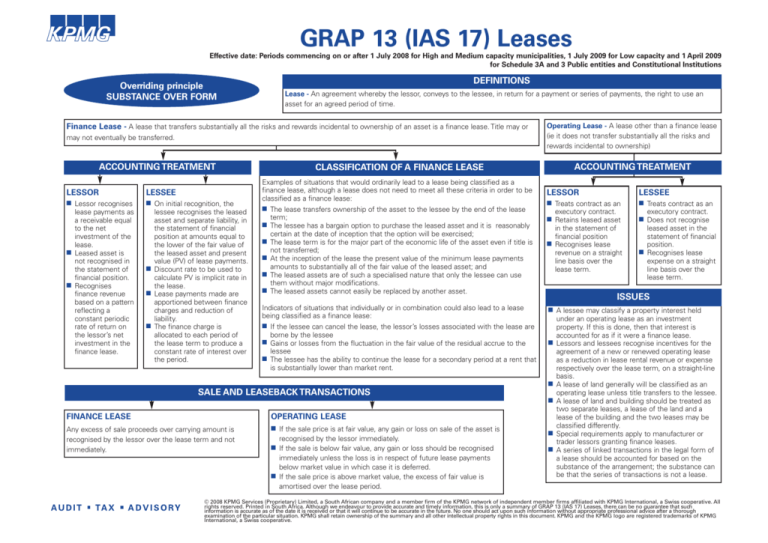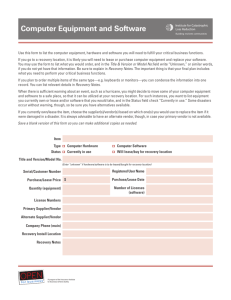
GRAP 13 (IAS 17) Leases
Effective date: Periods commencing on or after 1 July 2008 for High and Medium capacity municipalities, 1 July 2009 for Low capacity and 1 April 2009
for Schedule 3A and 3 Public entities and Constitutional Institutions
Overriding principle
SUBSTANCE OVER FORM
DEFINITIONS
Lease - An agreement whereby the lessor, conveys to the lessee, in return for a payment or series of payments, the right to use an
asset for an agreed period of time.
Finance Lease - A lease that transfers substantially all the risks and rewards incidental to ownership of an asset is a finance lease. Title may or
may not eventually be transferred.
ACCOUNTING TREATMENT
LESSOR
LESSEE
■ Lessor recognises
■ On initial recognition, the
lease payments as
a receivable equal
to the net
investment of the
lease.
■ Leased asset is
not recognised in
the statement of
financial position.
■ Recognises
finance revenue
based on a pattern
reflecting a
constant periodic
rate of return on
the lessor’s net
investment in the
finance lease.
lessee recognises the leased
asset and separate liability, in
the statement of financial
position at amounts equal to
the lower of the fair value of
the leased asset and present
value (PV) of lease payments.
■ Discount rate to be used to
calculate PV is implicit rate in
the lease.
■ Lease payments made are
apportioned between finance
charges and reduction of
liability.
■ The finance charge is
allocated to each period of
the lease term to produce a
constant rate of interest over
the period.
Operating Lease - A lease other than a finance lease
(ie it does not transfer substantially all the risks and
rewards incidental to ownership)
ACCOUNTING TREATMENT
CLASSIFICATION OF A FINANCE LEASE
Examples of situations that would ordinarily lead to a lease being classified as a
finance lease, although a lease does not need to meet all these criteria in order to be
classified as a finance lease:
■ The lease transfers ownership of the asset to the lessee by the end of the lease
term;
■ The lessee has a bargain option to purchase the leased asset and it is reasonably
certain at the date of inception that the option will be exercised;
■ The lease term is for the major part of the economic life of the asset even if title is
not transferred;
■ At the inception of the lease the present value of the minimum lease payments
amounts to substantially all of the fair value of the leased asset; and
■ The leased assets are of such a specialised nature that only the lessee can use
them without major modifications.
■ The leased assets cannot easily be replaced by another asset.
Indicators of situations that individually or in combination could also lead to a lease
being classified as a finance lease:
■ If the lessee can cancel the lease, the lessor’s losses associated with the lease are
borne by the lessee
■ Gains or losses from the fluctuation in the fair value of the residual accrue to the
lessee
■ The lessee has the ability to continue the lease for a secondary period at a rent that
is substantially lower than market rent.
LESSOR
LESSEE
■ Treats contract as an
■ Treats contract as an
executory contract.
■ Retains leased asset
in the statement of
financial position
■ Recognises lease
revenue on a straight
line basis over the
lease term.
ISSUES
■
■
■
OPERATING LEASE
Any excess of sale proceeds over carrying amount is
recognised by the lessor over the lease term and not
immediately.
■ If the sale price is at fair value, any gain or loss on sale of the asset is
recognised by the lessor immediately.
■ If the sale is below fair value, any gain or loss should be recognised
immediately unless the loss is in respect of future lease payments
below market value in which case it is deferred.
■ If the sale price is above market value, the excess of fair value is
amortised over the lease period.
leased asset in the
statement of financial
position.
■ Recognises lease
expense on a straight
line basis over the
lease term.
■ A lessee may classify a property interest held
SALE AND LEASEBACK TRANSACTIONS
FINANCE LEASE
executory contract.
■ Does not recognise
■
■
under an operating lease as an investment
property. If this is done, then that interest is
accounted for as if it were a finance lease.
Lessors and lessees recognise incentives for the
agreement of a new or renewed operating lease
as a reduction in lease rental revenue or expense
respectively over the lease term, on a straight-line
basis.
A lease of land generally will be classified as an
operating lease unless title transfers to the lessee.
A lease of land and building should be treated as
two separate leases, a lease of the land and a
lease of the building and the two leases may be
classified differently.
Special requirements apply to manufacturer or
trader lessors granting finance leases.
A series of linked transactions in the legal form of
a lease should be accounted for based on the
substance of the arrangement; the substance can
be that the series of transactions is not a lease.
© 2008 KPMG Services (Proprietary) Limited, a South African company and a member firm of the KPMG network of independent member firms affiliated with KPMG International, a Swiss cooperative. All
rights reserved. Printed in South Africa. Although we endeavour to provide accurate and timely information, this is only a summary of GRAP 13 (IAS 17) Leases, there can be no guarantee that such
information is accurate as of the date it is received or that it will continue to be accurate in the future. No one should act upon such information without appropriate professional advice after a thorough
examination of the particular situation. KPMG shall retain ownership of the summary and all other intellectual property rights in this document. KPMG and the KPMG logo are registered trademarks of KPMG
International, a Swiss cooperative.




